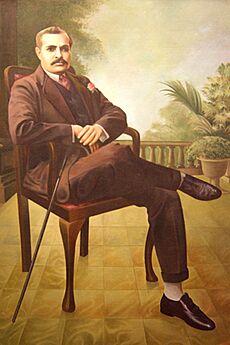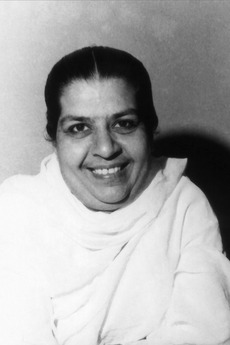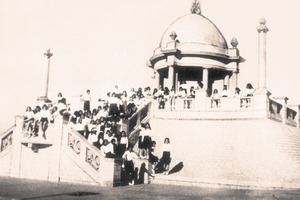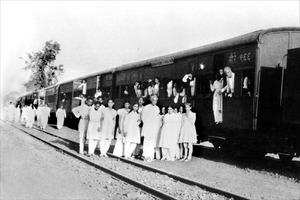Brahma Kumaris facts for kids
 |
|
| Formation | 1936 |
|---|---|
| Founder | Lekhraj Kripalani |
| Type | Spiritual organisation |
| Legal status | Foundation |
| Purpose | Educational, Philanthropic, Spiritual, Meditation |
| Headquarters | Mount Abu, Rajasthan, India |
| Location |
|
|
Area served
|
Worldwide |
|
Key people
|
BK Shivani, Dadi Janki, Dadi Prakashmani and Dadi Hriday Mohini |
The Brahma Kumaris (which means "Daughters of Brahma") is a spiritual group that started in Hyderabad, Sindh, Pakistan in the 1930s. It was founded by Lekhraj Kripalani. The group teaches that people should look beyond things like race, nationality, religion, and gender. They believe everyone is a soul, not just a body. Through meditation, they aim to create a world where everyone understands they are souls. Members believe all souls are good and that God is the source of all goodness.
By 2019, the Brahma Kumaris had over 8,000 centers in 110 countries. They had more than one million members. Women continue to hold important leadership roles in the organization.
Contents
How the Brahma Kumaris Began
The Brahma Kumaris started in Hyderabad, Sindh, which was then part of northwest India. Today, this area is in Pakistan. At first, they were called Om Mandali. Members would chant Om together. After chanting, they would have spiritual discussions. These early talks were connected to the Bhagavad Gita, a famous ancient text.
The founder, Lekhraj Khubchand Kirpilani, was a jewelry businessman. People also knew him as Om Baba. In 1935, he had special spiritual experiences and visions. After these, he left his business. He then started Om Mandali. He felt a greater power was guiding him. Many people who attended the discussions also had spiritual experiences. Most of the early members were women and children. They came from a wealthy merchant background. Their husbands and fathers were often away on business trips.
About three years after it began, Om Mandali became known for valuing women's roles. It also did not follow the traditional caste system. The group chose a 22-year-old woman, Radhe Pokardas Rajwani, as its president. Her leadership team included eight other women. People from any background were welcome at their meetings. The group also supported young women choosing not to marry. Married women could also choose a spiritual path that included not having physical relationships. In India, at that time, men usually made these life decisions.
A group of influential men formed to oppose Om Mandali. They called themselves the 'Anti-Om Mandali Committee'. On June 21, 1938, this group protested outside Om Mandali. They stopped members from entering and caused a lot of trouble. Women attending the talks faced verbal abuse. There was even an attempt to burn down the building. Police made several arrests. Many women and girls experienced harm at home.
The protests led to legal action against both groups. On August 16, 1938, a local judge ordered Om Mandali to stop meeting. However, this ban was overturned on November 21, 1938. This happened after an appeal to the Sindh High Court. The judges criticized the local magistrate. They said he tried to punish the victims for the trouble caused by others. After these events, Om Mandali decided to leave Hyderabad. They moved their activities to Karachi in late 1938. About 300 members moved with them.
On March 31, 1939, the government set up a special group to look into Om Mandali's activities. When this group shared its findings, Om Radhe wrote a book called Is this Justice?. She criticized the special group, saying it had no legal basis. She also said it made decisions without hearing from Om Mandali. In May 1939, the government used these findings to ban Om Mandali again. They called it an "unlawful association." But Om Mandali kept holding their meetings. The government did not strongly enforce the ban. Because of this, the opposing committee tried to harm Om Baba, but it was not successful.
Growing and Spreading
In May 1950, Om Mandali moved to Mount Abu in Rajasthan, India. In 1952, they started offering a more organized teaching program. This was a seven-lesson course for the public.
The Brahma Kumaris began to expand internationally in the mid-1950s. From the 1970s, they spread to London and then across Western countries. You can often see their spiritual museums in most major Indian cities.
In 1980, the Brahma Kumaris became a registered nongovernmental organisation with the United Nations Department of Global Communications. In 1983, they gained a special status with the Economic and Social Council at the United Nations. This allowed them to advise the UN.
Most of the leaders and members of the Brahma Kumaris are women. For example, in the UK, women make up 80% of the members. Many centers are in followers' homes. Most members tend to be from middle- or upper-class backgrounds. Estimates for their worldwide membership have varied. In 2000, it was around 450,000.
Core Beliefs
The Brahma Kumaris see themselves as a spiritual teaching group, not just a religion. They have moved away from their original Hindu connections.
Understanding the Self
The Brahma Kumaris believe humans have two parts. There is the visible body, which includes things like status and possessions. Then there is a subtle energy called the soul. How a person acts shows the nature of their soul. Actions done with love, peace, happiness, or humility show the true essence of the soul.
They teach that the soul is a tiny point of spiritual light. It lives in the forehead of the body it uses. They believe all souls originally lived with God in a "Soul World." This world is full of light, peace, and quiet.
The Brahma Kumaris teach that souls enter bodies to experience life. This helps them express their personality. Unlike some other Eastern beliefs, they do not believe a human soul can be reborn into an animal.
The Supreme Soul (God)
The Brahma Kumaris call God the "Supreme Soul." They believe God is invisible and eternal. God is seen as a point of living light, like a human soul. However, God does not have a physical body. God also does not go through the cycle of birth, death, and rebirth. God is seen as perfectly embodying all good qualities, powers, and values. They believe God is the unconditionally loving parent of all souls. This is true for everyone, no matter their religion, gender, or culture.
Understanding Karma
The Brahma Kumaris believe that every action a soul performs will have a matching result. They teach that the future of a soul's next body depends on how it acts in this life. Through meditation, people can change their thoughts and actions. The Brahma Kumaris believe this helps people improve their "karmic account." This leads to a better life now and in the future.
The Cycle of Time
The Brahma Kumaris have a unique view of time. They believe the universe follows an eternal, natural 5,000-year cycle. This cycle has four main ages, called yugas:
- The Golden Age (Satya Yuga)
- The Silver Age (Treta Yuga)
- The Copper Age (Dvapara Yuga)
- The Iron Age (Kali Yuga)
Each age lasts for 1250 years. They believe that at the end of the Iron Age, there will be a "Destruction." This event will cleanse the Earth. Then, the cycle can begin again. The current time is sometimes called a "Confluence Age." It is seen as the meeting point between the Iron Age and the Golden Age.
The first half of the cycle (Golden and Silver ages) is seen as a time of "soul conscious living." The Brahma Kumaris describe this as a "heaven on earth." They believe humans were fully good and lived in harmony with nature. People naturally understood themselves as souls.
The Brahma Kumaris believe that modern civilization will be transformed. They see this as part of a natural cycle. When the organization started, there was a focus on a physical transformation of the world. As the group grew, they saw events like World War II. The idea of transformation became more important.
Daily Practices
Meditation for Inner Peace
The Brahma Kumaris teach a type of meditation to help students purify their minds. During this meditation, students sit quietly. They then repeat positive thoughts about the soul's eternal nature. They also think about their own pure nature and the nature of God. The goal is to learn to stay in a meditative state while doing everyday activities. Because of this, meditation is usually taught and practiced with open eyes.
Good Wishes and Pure Feelings
The Brahma Kumaris believe everyone is a spiritual being. This leads to their practice of Shubbhawna (pure feelings) and Shubkamna (good wishes). They believe that negative feelings come from judging people by outside things. These include race, religion, gender, or looks. When people practice seeing the good in everyone, they replace prejudice. They see one Spiritual Parent and one human family. This brings values like respect, love, peace, and happiness. A key idea for the Brahma Kumaris is: "When we change, the world changes." They believe changing oneself is an important way to help the world.
Daily Study (Murli)
Brahma Kumaris students study something called the murli. The Hindi word murli means "flute." It is a spoken study, read aloud each morning in most Brahma Kumaris centers worldwide. The murlis are believed to be messages received through a special way of communication.
There are two types of murli:
- Sakar Murlis are believed to be the original words spoken by the Supreme Soul through Brahma Baba.
- Avyakt Murlis are spoken by BapDada. Brahma Kumaris believe BapDada is God and the soul of their founder. BapDada is believed to speak through a senior Brahma Kumaris member, Dadi Gulzar.
Avyakt murlis are still being spoken at the Brahma Kumaris headquarters in India. Students must complete a special foundation course. They also need to attend morning Murli class before visiting the headquarters.
The Brahma Kumaris believe God's purpose is to spiritually re-awaken humanity. This will remove all sadness and negativity. They do not believe God created matter, as they see matter as eternal.
Pratibha Patil, a former President of India, once said she spoke to "Baba" (a term Brahma Kumaris use for God). This happened at the Brahma Kumaris headquarters in Mount Abu, Rajasthan. Patil stated that Baba had indicated a great responsibility was coming her way.
In his book "Ignited Minds," Abdul Kalam shared a special experience. On February 3, 2002, he visited the Brahma Kumari Spiritual Academy in Mount Abu. He saw a remarkable event. One of the members, Dhadhi Gurzar, seemed to become a channel for the deity of the Brahma Kumaris, Shiva Baba. Dr. Kalam observed her personality change. Her face became bright, and her voice deepened. She spoke about four important treasures: Knowledge, Yoga, Virtue, and Service.
Lifestyle Choices

The Brahma Kumaris suggest a certain lifestyle. This helps members gain more control over their physical senses. However, many people participate casually. They choose which beliefs and practices they want to follow from this list:
- Choosing not to marry or have physical relationships.
- Eating a Sattvic lacto-vegetarian diet. This means no eggs, onions, garlic, or very spicy foods. Food should only be cooked by themselves or other Brahma Kumaris members.
- Not using alcohol, tobacco, or non-prescription drugs.
- Daily early-morning meditation (Amrit Vela) from 4:00 to 4:45 a.m.
- Daily morning class around 6:30 a.m.
- Often wearing white clothes to symbolize purity.
- Preferring to spend time with other Brahma Kumaris followers.
Activities and Community Work
Education and Courses
The Brahma Kumaris traditionally offer an "introduction to meditation" course. It has seven two-hour sessions. These sessions teach their open-eyed meditation technique and their philosophy. The organization also offers courses on "positive thinking" and "self management leadership." They also have programs in prisons.
With support from Vicente Fox, the Brahma Kumaris shared their meditation and philosophy with the government of Mexico. This was through a program called "Self Management Leadership" (SML). The SML course is based on the Brahma Kumaris philosophy. It is a key part of their management ideas. Many trained people led programs. About 25,000 top government officials took part.
Renewable Energy Projects
The Brahma Kumaris have started several projects to help the environment. Their work in solar and sustainable energy is notable. In 2007, they developed the world's largest solar cooker. They also built a solar thermal power plant in Talheti, Abu Road. This is near their international headquarters in Mount Abu. This 25-acre site is designed to produce 22,000 kilowatt-hours of electricity daily. The governments of India and Germany helped fund this project.
Sustainable Yogic Agriculture
Sustainable Yogic Agriculture (SYA) is a program that began in Northern India in 2009. This program is a partnership between Sardarkrushinagar Dantiwada Agricultural University in Gujarat, India, and the Brahma Kumaris Rural Development wing. The Indian Government has publicly supported this program. Radha Mohan Singh, a key minister in Narendra Modi's government, announced the government's support.
With government help, the program was redesigned. It is now called Akhil Bharatiya Krushak Sashakatikaran Abhijan (ABKSA). It started in December 2015. ABKSA expands the original SYA program. It now includes teaching meditation and self-empowerment to farmers. This may help address challenges faced by farmers in India. ABKSA has three main parts:
- A self-empowerment program for Indian farmers.
- Ongoing research to see if meditation can improve crop yields.
- Education on a mix of traditional and organic farming methods.
A basic idea of the Brahma Kumaris' environmental work is that thoughts and consciousness can affect nature.
In 2012, experiments were done with top agricultural universities in India. They wanted to see if Brahma Kumaris meditation, combined with organic farming, could positively affect crop growth. An article reviewed two studies on SYA. One study was by G.B. Pant University of Agriculture and Technology (GBPUAT). The other was by Sardarkrushinagar Dantiwada Agricultural University (SDUAT). The review reported that Brahma Kumaris meditation techniques improved seed growth and germination rates. It also increased helpful microbes in the soil.
Healthcare Services
In 1991, the Brahma Kumaris, Ashok Mehta, and the brothers Gulab and Khubchand Watumull opened the J Watumull Global Hospital. This hospital is in the Sirohi district of Rajasthan. It provides medical care to local people.
United Nations Consultative Status
In 1998, the Brahma Kumaris gained a special advisory status with the United Nations Department of Economic and Social Affairs. This means they can offer advice and expertise to the UN.
|
See also
 In Spanish: Brahma Kumaris para niños
In Spanish: Brahma Kumaris para niños










